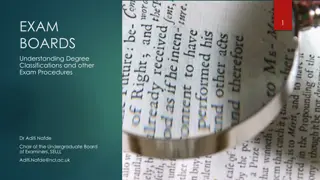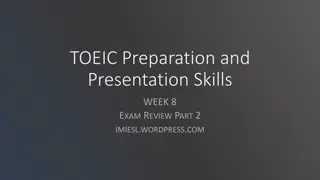Understanding Combined Gas Law and Ideal Gas Law for Final Exam Preparation
Explore the concepts of Combined Gas Law, Boyle's Law, Charles's Law, Gay-Lussac's Law, and their reflection in the Ideal Gas Law. Learn how to solve problems using these laws, prepare for your final exam scheduled for Tuesday, December 12 at 12:30 in the specified room. Dive into in-class practice to enhance your understanding.
Download Presentation

Please find below an Image/Link to download the presentation.
The content on the website is provided AS IS for your information and personal use only. It may not be sold, licensed, or shared on other websites without obtaining consent from the author. Download presentation by click this link. If you encounter any issues during the download, it is possible that the publisher has removed the file from their server.
E N D
Presentation Transcript
Read Chapter 8 (Combined Gas Law and Ideal Gas Law) Final Exam Tuesday 12 Dec 12:30 (This room)
The `Combined Gas Law (page 281, equation 8.2): when gas moles (n) are constant P1V1 T1 = P2V2 T2 P in atm V in liters (L) T in K
Where the Combined Gas comes from (see pages 285-290) 1) Boyle s Law: hold n and T constant and let P and V vary Boyle s law in words: If P increases, V decreases Boyle s law in math-speak: P = a/V => P1V1=P2V2 Boyle s Law Observed httsp://www.youtube.com/watch?v=N5xft2fIqQU
Where the Combined Gas comes from (continued) 2) Charle s Law: hold n and P constant and let T and V vary Charle s law in words: If T increases, V increases Charle s law in math-speak: V = bT => V1 = V2 T1 T2 Charle s Law Observed: can crush
Where the Combined Gas comes from (continued) 3) Gay-Lussac s Law: hold n and V constant and let T and P vary Gay-Lussac s law in words: If T increases, P increases Gay-Lussac s law in math-speak: P = cT P1 = P2 T1 T2 Gay-Lussac s Law Observed: egg in a bottle egg https://www.youtube.com/watch?v=xceBXe5YHj0 P vs T https://www.youtube.com/watch?v=1pVVZGOBIVg
How Boyle, Gay How Boyle, Gay- -Lussac and Charles Laws are reflected in the Lussac and Charles Laws are reflected in the Combined Gas Law Combined Gas Law (when n is constant) (when n is constant) Gas Law Gas Law Equation Equation Conditions Conditions Name of Name of Gas Law Gas Law constant n P1V1 = T1 P2 V2 T2 Combined Gas Law constant n,P Charles Law (P1=P2) P1V1 = T1 P1V1 = T1 P2 V2 T2 P2 V2 T2 constant n, T Boyle s Law (T1=T2) Gay-Lussac s Law (V1=V2) P1V1 T1 = P2 V2 T2 constant n, V
In-class practice on board working combined gas law problems
An ideal gas at constant V and P=2 atm is heated An ideal gas at constant V and P=2 atm is heated from 300 to 600 K. What is the final P ? from 300 to 600 K. What is the final P ? A. 1 atm B. 2 atm C. 3 atm D. 4 atm 25% 25% 25% 25% 1 atm 2 atm 3 atm 4 atm
COMBINED GAS LAW PROBLEMSBOARD WORK 1. A sample of oxygen gas is expanded from 20 to 50 liters at constant temperature. The final pressure is 4 atm. What was the initial pressure ? P1=10 atm
A sample of ideal gas arrives at 300K when expanded from 3 to 9 L at constant P. What was the original temperature ? 25% 25% 25% 25% A. 900 K B. 100 K C. 600 K D. 150 K 900 K 100 K 600 K 150 K
COMBINED GAS LAW PROBLEMSBOARD WORK (CONT.) 2. A child s balloon originally occupies 5 liters at sea level (P=1 atm) and room temperature (300 K) . It is released and is allowed to rise to an altitude where the pressure is 0.25 atm and the temperature is 150 K. What is the balloon s new volume ? 10 L
An ideal gas in a fixed volume and an initial pressure of 10 atm and initial T of 177 C has a final pressure of 3.33 atm. What is the final T(K) (K=C+273) 25% 25% 25% 25% A. 150 K B. 59 K C. 450 K D. 531 K 59 K 150 K 450 K 531 K
COMBINED GAS LAW PROBLEMSBOARD WORK (CONT.) 3. The volume of a piston at fixed pressure changes as it is cooled from 500 oC to 250oC. If the final volume is 6.76 L, what is the initial volume ? V1=10 L
COMBINED GAS LAW PROBLEMSBOARD WORK (CONT.) 4. Autoclaves are essentially pressure cookers. At 1 atm, steam has a temperature of 100o C. Would you expect the pressure to double if the autoclave to attains a steam temperature of 200oC ? K ratio is not 200/100 a) NO must convert C What pressure do you actually expect to reach at 200 oC? 473.15 =1.73 atm 373.15
What happens if we let n vary too ??
Ideal Gas Law: letting T,P,V, n and gas ID all vary. P 277-8 P (piston head) Hypothetical Gas Property testing apparatus piston walls insulation T n V (varies G A S GAS VALVE Heating/cooling
Ideal Gas derived: Why gas identity not important ..see what happens Vary gas and fix three out of four gas variables Gas ID (and size) not important Variables fixed at constant values (`STP ) Gas varied H2(2) He(4) T(OC) P(atm) n(moles) V(obs) 22.414 22.414 22.414 22.414 22.414 0o 1 1 0o 1 1 N2(28) CO2(44) SF6 (146) 0o 1 1 0o 1 1 0o 1 1 STP =Standard Temperature & Pressure ( and n=1)
Ideal Gas Law derived (cont.): origin of R What happens if we hold different sets of three variables constant and watch the fourth for a given gas ? Anything constant ?? P(atm) V(L) T(K) n(moles) PV/nT 0.08206 2 400 1 16.43 1 24.65 0.08206 0.08206 0.08206 300 1 5 2 300 0.406 3 101 5 5
PV = 0.08205746 nT =R (atm L) (mol K ) PV =nRT Or
The ideal gas law leads to : molecular masses verification of stoichiometries
1. An 11 gram sample of a gas occupies 2.0 liters at 2.0538 atm and 200 K. What is the molecular mass of the gas ? (R=0.08206) 44 g/mol 2. What volume is occupied by 0.09 g of gas phase H2O (MW=18 g/mol) at 300 K and 0.123 atm ? 1.00 L
3. A 1.5 liter can of gas reaches a pressure of 45.45 atm at 500 K. How many molecules of gas are in the can ? (R=0.08206 atm L/K mol) 1 mol count =6.02*1023 1.0*1024























